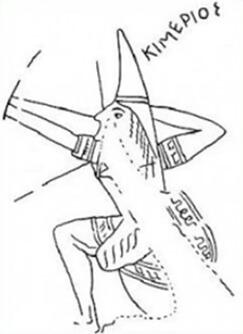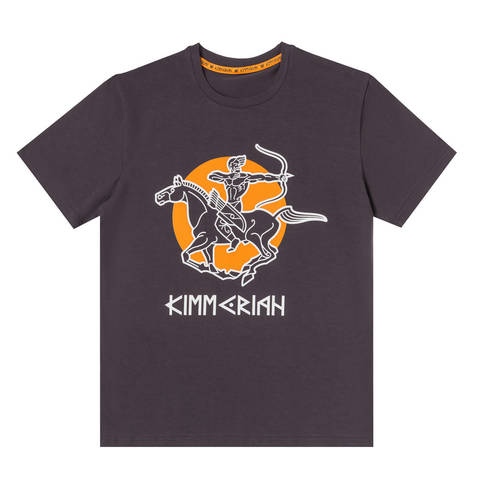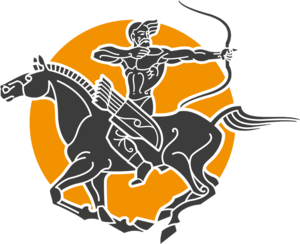Киммерия, как точка сборки
Древнейшим из индоевропейских народов Восточной Европы, чье название нам точно известно, были киммерийцы, занимавшие причерноморские степи приблизительно с 1300 года до нашей эры. В районе одиннадцатого века они овладели секретом получения железа из болотной руды. Cогласно археологическим находкам, получает распространение цельнометаллическое оружие. В 713 году до н.э. скифы начали вытеснять их с привычных кочевий в результате чего киммерийцы обошли Кавказский хребет через территорию современной Грузии, напали на Урарту в Закавказье, скифы же обошли Кавказ через территорию современного Дагестана (левая и правая вертикальные стрелки на карте ниже)

Иллюстрация 1. Карта миграции киммерийцев через Кавказский хребет
Позже киммерийцы вторглись в Малую Азию и заняли часть Каппадокии, но между 637 и 626 году до н.э., оттесняемые скифами к побережью Черного моря, были разбиты царем Алиаттом из Лидии.

Иллюстрация 2. Конные киммерийские лучники - рисунок на этруской вазе
В западных источниках популярна теория о второй ветви киммерийцев, которые отступали вдоль Черного моря до поймы Днестра. Там произошел раскол — часть царей решила двигаться назад, в результате междоусобной битвы погибло около 10000 сторонников возвращения, после чего оставшиеся вошли во Фракию и были снова упомянуты уже в 279 году до нашей эры во время атаки на Дельфы в Греции совместно с иллирийцами, но были разбиты. Позже 113-101 годах до н.э. они вторглись в Римскую империю вместе с тевтонами и хотя имели некоторый успех вначале, были наголову разбиты Мариусом возле итальянского города Верчелли. Большинство мужчин полегли в битве, а более 80 тысяч женщин и детей были проданы в рабство. Маленькая группа уцелевших бежала на полуостров Ютланд, в земли современной Дании.
Это подтверждается распределением Y хромосомы Q гаплогруппы среди европейского населения, что совпадает с этапами «боевого пути» киммерийцев. Обратите внимание как уходят ее следы на север против течения Дона.

Иллюстрация 3. Общая карта миграции киммерийцев
Считается, что римские авторы упоминают об этих событиях неправильно называя киммерийцев кимврами, противники же данной теории утверждают, что кимвры это германское племя и никакого отношения к вышедшим из Крыма кочевникам не имеет. Ютланд же является изначальной территорией обитания
Хотя примерно в это время германское племя готов откочевало в Крым с Балтийского моря и жило там, частично сохраняя свою культуру до 18 века! Это в какой-то мере подтверждает теорию о существовании в причерноморских степях зоны смешивания германских племен и кочевников и формирования так называемых кельтоскифов.

«Вот из этих-то мест и двинулись на Италию варвары, которых сперва называли киммерийцами, а позже, и не без основания, кимврами. Но всё это скорее предположение, нежели достоверная история. Что же касается численности варваров, то многие утверждают, будто их было не меньше, а больше, чем сказано выше» (Кузьмин А. Г. Из предыстории народов Европы)

Иллюстрация 5. Карта расположения находок скифской материальной культуры. Популярна теория о том, что скифы и киммерийцы были двумя враждующими ветвями одного народа.

Иллюстрация 6. Рисунок киммерийского лучника на греческой вазе
Где истина сейчас судить сложно, целью же данной статьи была попытка почувствовать дух этих древних конных лучников европеоидов, начавших свой путь от берегов привычного нам Азовского моря и растворившихся в Европе.
Источники:
- Тереножкин А. И. Киммерийцы / А. И. Тереножкин. — Киев : Наукова думка, 1976. — 224 с.
- https://aleximreh.wordpress.com/2014/12/20/the-getes-big-bang-theory/
- https://peaceandjustice.freeforums.net/thread/10/genomic-data-reveal...?page=22&page=
- Википедия
 En
En Ru
Ru


